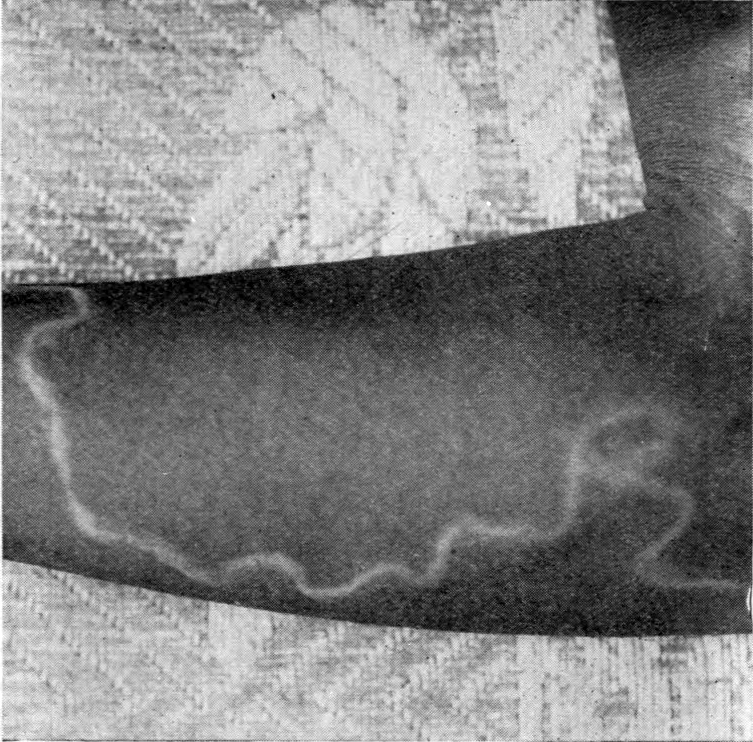|
Sciaridae
The Sciaridae are a family of fly, flies, commonly known as dark-winged fungus gnats. Commonly found in moist environments, they are known to be a pest of mushroom farms and are commonly found in household plant pots. This is one of the least studied of the large Diptera families, probably due to the small size of these insects and the similarity among species. Currently, around 1700 species are described, but an estimated 20,000 species are awaiting discovery, mainly in the tropics. More than 600 species are known from Europe. Description Adult Sciaridae are small, dark flies 1–11 mm long and usually <5 mm long. They have a characteristic wing venation: there is no cross vein except for a short rs at the wing base, the anterior veins are a short R1 and a long R5, vein M has a simple fork with a long stem, and CuA1 has a fork with a short stem. Larval Sciaridae are slender and lack legs. They are white except for a black head, and their skin is ... [...More Info...] [...Related Items...] OR: [Wikipedia] [Google] [Baidu] |
Sciaridae Ovipostion On Urtica - 2012-06-10
The Sciaridae are a family of flies, commonly known as dark-winged fungus gnats. Commonly found in moist environments, they are known to be a pest of mushroom farms and are commonly found in household plant pots. This is one of the least studied of the large Diptera families, probably due to the small size of these insects and the similarity among species. Currently, around 1700 species are described, but an estimated 20,000 species are awaiting discovery, mainly in the tropics. More than 600 species are known from Europe. Description Adult Sciaridae are small, dark flies 1–11 mm long and usually <5 mm long. They have a characteristic wing venation: there is no cross vein except for a short rs at the wing base, the anterior veins are a short R1 and a long R5, vein M has a simple fork with a long stem, and CuA1 has a fork with a short stem. Larval Sciaridae are slender and lack legs. They are white except for a black head, and their skin is slig ... [...More Info...] [...Related Items...] OR: [Wikipedia] [Google] [Baidu] |
List Of Sciaridae Genera
This is a list of 96 genera in the family Sciaridae, dark-winged fungus gnats. Sciaridae genera * '' Acuatella'' * '' Aerumnosa'' * '' Afrosciara'' * '' Allopnyxia'' * '' Amesicrium'' * '' Angustosciara'' * '' Apelmocreagris'' * '' Archicratyna'' * '' Austrosciara'' * '' Baeosciara'' Tuomikoski, 1960 * '' Brachisia'' * '' Bradysia'' Winnertz, 1867 * '' Bradysiopsis'' * '' Camptochaeta'' * '' Cesathrix'' * '' Chaetosciara'' * '' Claustropyga'' * '' Corynoptera'' * '' Cottia'' * '' Cratyna'' * '' Ctenosciara'' * '' Dichopygina'' * '' Dodecasciara'' * '' Dolichosciara'' * '' Edidapus'' * '' Epidapus'' (Epidapus) unistylatus Röschmann & Mohrig, 1995 * '' Eugnoriste'' Coquillett, 1896 * '' Euricrium'' * '' Eurobradysia'' * '' Eurysciara'' * '' Faratsiho'' * '' Gephyromma'' * '' Hermapterosciara'' * '' Hybosciara'' * '' Hyperlasion'' Schmitz * '' Keilbachia'' * '' Leptosciarella'' * '' Leucosciara'' * '' Lobosciara'' * '' Lycoriella'' * '' Manusciari ... [...More Info...] [...Related Items...] OR: [Wikipedia] [Google] [Baidu] |
Fungus Gnat
Fungus gnats are small, dark, short-lived gnats, of the families Sciaridae, Diadocidiidae, Ditomyiidae, Keroplatidae, Bolitophilidae, and Mycetophilidae (order Diptera); they comprise six of the seven families placed in the superfamily Sciaroidea. They are also Flies. Description The larvae of most species feed on fungi growing on soil, helping in the decomposition of organic matter. However some species are predatory, including those in the genus ''Arachnocampa'' of family Keroplatidae – the "glowworms" of Australia and New Zealand. The adults are long, and are occasionally pollinators of plants and carriers of mushroom spores. They also may carry diseases such as pythium (which causes " damping-off" to kill seedlings) on their feet. Most fungus gnats are weak fliers, and can often be seen walking rapidly over plants and soil, rather than flying. However, when airborne, the gnats may be quite annoying to humans by flying into their faces, eyes, and noses, both indoo ... [...More Info...] [...Related Items...] OR: [Wikipedia] [Google] [Baidu] |
Sciara Hemerobioides
''Sciara hemerobioides'' is a species of fly in the family Sciaridae. It is found in the Palearctic The Palearctic or Palaearctic is a biogeographic realm of the Earth, the largest of eight. Confined almost entirely to the Eastern Hemisphere, it stretches across Europe and Asia, north of the foothills of the Himalayas, and North Africa. Th .... This species has a conspicuous yellow abdomen with a dark ventral band. It belongs to a group referred to as fungus gnats. The larvae do feed on fungi but also eat dead leaves and compost, the adults feed on nectar and can be found on umbellifers and other flowers. References Sciaridae Insects described in 1763 Taxa named by Giovanni Antonio Scopoli {{Sciaroidea-stub ... [...More Info...] [...Related Items...] OR: [Wikipedia] [Google] [Baidu] |
Mycetophilidae
Mycetophilidae is a family of small flies, forming the bulk of those species known as fungus gnats. About 3000 described species are placed in 150 genera, but the true number of species is undoubtedly much higher. They are generally found in the damp habitats favoured by their host fungi and sometimes form dense swarms. Adults of this family can usually be separated from other small flies by the strongly humped thorax, well-developed coxae, and often spinose legs, but identification within the family between genera and species generally requires close study of microscopic features such as subtle differences in wing venation and variation in chaetotaxy and genitalia. The terrestrial larvae usually feed on fungi, especially the fruiting bodies, but also spores and hyphae, but some species have been recorded on mosses and liverworts. The larvae of some species, while still being associated with fungi, are at least partly predatory. Some species are attracted to the fungus smell o ... [...More Info...] [...Related Items...] OR: [Wikipedia] [Google] [Baidu] |
Lasthenia Conjugens
''Lasthenia conjugens'', commonly known as Contra Costa goldfields, is an endangered species of wildflower endemic to a limited range within the San Francisco Bay Area of the state of California, USA. Specifically this rare species occurs in Napa, Santa Barbara, Solano, Contra Costa, Santa Clara, Monterey and Alameda Counties. This annual herb typically flowers from March through June, and its colonies grow in vernal pool habitats at elevations not exceeding 100 meters above sea level. ''The Jepson Manual'' notes that the present distribution is limited to the deltaic Sacramento Valley, principally Napa and Solano Counties, but the historic range of ''L. conjugens'' is known to be significantly wider. In any case, historically the range has included parts of the North Coast, Sacramento Valley, and San Francisco Bay Area as well as the South Coast. Alternatively and less frequently this taxon has been referred to as ''Baeria fremontii var. conjugens''. Even though this pla ... [...More Info...] [...Related Items...] OR: [Wikipedia] [Google] [Baidu] |
Haplodiploidy
Haplodiploidy is a sex-determination system in which males develop from unfertilized eggs and are haploid, and females develop from fertilized eggs and are diploid. Haplodiploidy is sometimes called arrhenotoky. Haplodiploidy determines the sex in all members of the insect orders Hymenoptera ( bees, ants, and wasps) and Thysanoptera ('thrips'). The system also occurs sporadically in some spider mites, Hemiptera, Coleoptera ( bark beetles), and rotifers. In this system, sex is determined by the number of sets of chromosomes an individual receives. An offspring formed from the union of a sperm and an egg develops as a female, and an unfertilized egg develops as a male. This means that the males have half the number of chromosomes that a female has, and are haploid. The haplodiploid sex-determination system has a number of peculiarities. For example, a male has no father and cannot have sons, but he has a grandfather and can have grandsons. Additionally, if a eusocial-insect c ... [...More Info...] [...Related Items...] OR: [Wikipedia] [Google] [Baidu] |
University Of Florida
The University of Florida (Florida or UF) is a public university, public land-grant university, land-grant research university in Gainesville, Florida, United States. It is a senior member of the State University System of Florida and a preeminent university in the state. The university traces its origins to 1853 and has operated continuously on its Gainesville campus since September 1906. After the Florida state legislature's creation of performance standards in 2013, the Florida Board of Governors designated the University of Florida as a "preeminent university". The University of Florida is one of three members of the Association of American Universities in Florida and is Carnegie Classification of Institutions of Higher Education, classified among "R1: Doctoral Universities – Very high research spending and doctorate production". The university is Higher education accreditation in the United States, accredited by the Southern Association of Colleges and Schools (SACS). ... [...More Info...] [...Related Items...] OR: [Wikipedia] [Google] [Baidu] |
Xenorhabdus
''Xenorhabdus'' is a genus of motile, gram-negative bacteria from the family of the Morganellaceae. All the species of the genus are only known to live in symbiosis with soil entomopathogenic nematodes from the genus '' Steinernema''. Although no free-living forms of ''Xenorhabdus'' have ever been isolated outside of the nematode host, the benefits for the bacteria are still unknown. However, it has been demonstrated that the nematode can't establish within its insect host without the bacteria. The tripartite ''Xenorhabdus''-nematode-insect interaction represents a model system in which both mutualistic and pathogenic processes can be studied in a single bacterial species. In the laboratory, some species are virulent even when artificially injected into the insect host, whereas others species need the nematode to affect the insect. Lifecycle # In the non-infestant-stage nematode living in the soil, ''Xenorhabdus'' spp. are carried in a specialized region of the intestine, t ... [...More Info...] [...Related Items...] OR: [Wikipedia] [Google] [Baidu] |
Nematode
The nematodes ( or ; ; ), roundworms or eelworms constitute the phylum Nematoda. Species in the phylum inhabit a broad range of environments. Most species are free-living, feeding on microorganisms, but many are parasitic. Parasitic worms (helminths) are the cause of soil-transmitted helminthiases. They are classified along with arthropods, tardigrades and other moulting animals in the clade Ecdysozoa. Unlike the flatworms, nematodes have a tubular digestive system, with openings at both ends. Like tardigrades, they have a reduced number of Hox genes, but their sister phylum Nematomorpha has kept the ancestral protostome Hox genotype, which shows that the reduction has occurred within the nematode phylum. Nematode species can be difficult to distinguish from one another. Consequently, estimates of the number of nematode species are uncertain. A 2013 survey of animal biodiversity suggested there are over 25,000. Estimates of the total number of extant species are su ... [...More Info...] [...Related Items...] OR: [Wikipedia] [Google] [Baidu] |




